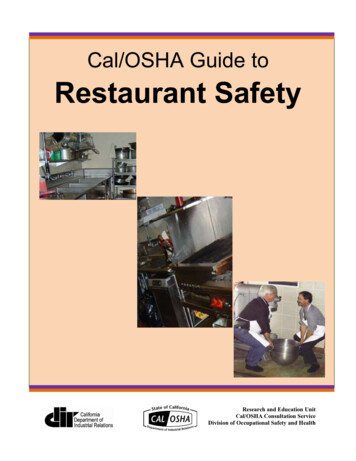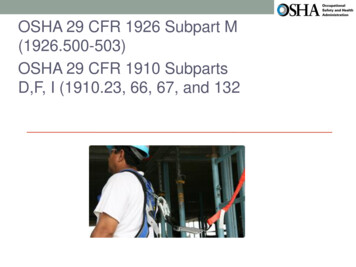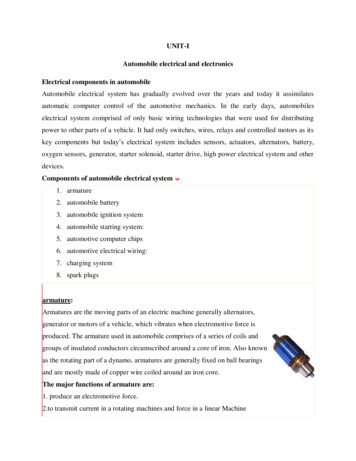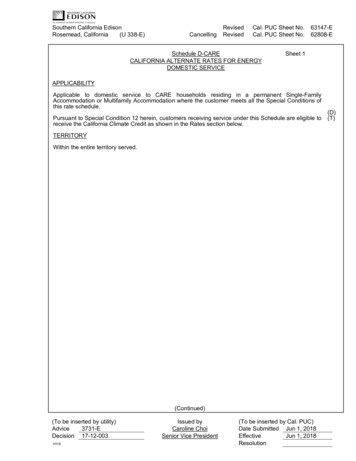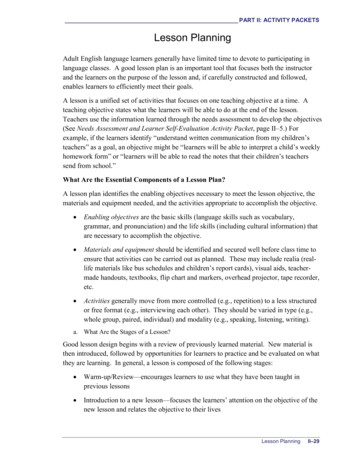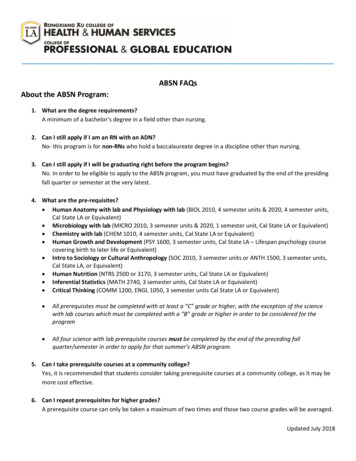
Transcription
Cal/OSHA Guide toElectrical SafetyCal/OSHA Consultation ServiceResearch and EducationDivision of Occupational Safety and Health
This guide is not meant to be either a substitute for or a legal interpretation ofthe occupational safety and health regulations. Readers shall refer directly toTitle 8 of the California Code of Regulations and the Labor Code for detailedinformation regarding the regulation’s scope, specifications, and exceptions andfor other requirements that may be applicable to their operations.Revised: October 2012Produced by the State of CaliforniaDepartment of Industrial RelationsCal/OSHA Consultation ServiceCal/OSHA safety and health publications are available atwww.dir.ca.gov/dosh/puborder.aspYou may also call Cal/OSHA Consultation Service offices listed on the backcover of this guide for information on how to get Cal/OSHA publications.
Cal/OSHA Guide toElectrical SafetyWhy is electrical safetyso important?This booklet explains some of the mostcommon electrical hazards andmeasures the law requires employers andemployees to take in order to provide a safeand healthful workplace.Workers such as electricians, apprentices,power line workers, and other groups ofemployees work directly with electricity andmay be exposed to dangerous conditions ifadequate precautions are not taken.Workers are injured or killed every year inCalifornia due to occupational accidentsinvolving uncontrolled exposure toelectricity. When shortcuts are taken andsafe procedures are not followed, loss oflife, permanent disfigurement, lost worktime, increased workers’ compensationcosts, and lawsuits can occur.Common electrical hazardsWith all electrical equipment operations, thereis the threat of shock and/or electrocution.Electrical workers are potentially exposed to avariety of hazards such as electric shock (themost common hazard), arc flashes, falls, andthermal burns.As per the Bureau of Labor Statistics, 163workers died from injuries from contact withelectric current in 2010. 76 workers died fromoverhead power lines in the same year.When you receive an electric shock, anelectric current runs through your bodybecause the body has become aconductor for electricity. Electrocutionoccurs when enough current flowsthrough your body to cease the functionsof vital organs and causes burns tomuscular and skin tissues.Source: US Department of Labor, Bureau of Labor StatisticsFatal occupational injuries by event or exposure, 2009-2010A worker was electrocuted from accidentalcontact with an overhead power line. Thevictim was carrying a metal ladder upright tohis work van. The foreman and several of hisco-workers observed and verbally warnedhim about the overhead power line.However, several seconds later, the victim’sladder made contact with the overheadpower line and the victim fell to the groundsuffering fatal injuries.The following are samples of the mostcommon electrical safety related hazards thatwill pose a risk of being shocked and/orelectrocuted.1
Where can I find theCal/OSHA regulations forelectrical safety? Exposed wires and energized partsCal/OSHA regulations on electrical safetyrequire California employers to provideworkers with a safe and healthful workplace.These regulations are contained in Title 8 ofthe California Code of Regulations (T8CCR).Most of the electrical health and safetyregulations can be found in T8CCR, Chapter4, Subchapter 5 in the Electrical SafetyOrders, Sections 2299 through 2989(http://www.dir.ca.gov/Title8/sub5.html). Faulty/broken wiring or equipment Damaged outlets and missing covers Worn/damaged electrical cordsCal/OSHA regulations on electrical safety aregrouped by electrical voltage. Regulations forlow voltage (0-600V) are given in Sections2299-2599 and the regulations for highvoltage (above 600V) are given in Sections2700-2989. Improperly used extension cords Overloaded outletsSection 1518 addresses the safetyrequirements for the protection of yourselfand others from electric shock inconstruction. Section 1541 addresseselectrical safety requirements for excavationworks including subsurface installations.What can you do to protectyourself and others fromelectrical hazards? No warning signs Working under wet conditionsEmployees can prevent shocks andinjuries/electrocution from electrical hazardsby: Lack of or insufficient protective devices Unrestricted access to live exposed parts Lack of or insufficient personal protectiveequipment (PPE) Insufficient clearances around panels Lack of/improper lockout/tagout procedures Failure to maintain proper clearance fromoverhead lines Failure to follow manufacturer’s instructionwhen using electrically poweredequipment.2 Understanding electric shock andelectrocution Recognizing potential hazards aroundwork involving electricity Following Cal/OSHA requirements Maintaining clearances around panels Using proper protective devices Eliminating access to exposedenergized parts
2. The length of time the current flowsthrough your body Using proper PPE Using proper lockout/tagout proceduresIf the shock causes you to stay attachedto the electrical equipment, you couldreceive severe internal injury. The longerthe employee stays in contact, the longerthe exposure to the current flow, andhence the more severe the shock. Maintaining proper clearance fromoverhead lines Following proper procedures forconfined space/enclosed space/underground electrical work Following manufacturer’s instructions3. The path the current takes throughyour body Following safe work practicesThe most dangerous paths through thebody are those where the current goesthrough vital organs. For example, currentwhich runs from hand to hand, hand tohead, or foot to hand (or head) andpasses through vital organs can causesevere internal damage to vital organssuch as the heart and lungs.Understanding electric shock andelectrocutionIt is important to understand that shock canoccur even without physically contacting liveelectrical parts when there is enough voltage.Recognizing potential hazardsaround work involving electricityIt is the rate of current flowing through thebody, more than anything else, whichdetermines how severe the shock will be.Effects on the body could range from a minorshock to paralysis of vital organs such as thelungs and heart.Electrical workers need to recognize/identifyall of the potential hazards involving theirwork. They need to know that the chances ofbeing electrocuted go up when working:with high voltage, around water, whilesweating, and without wearing/using properprotective clothing.How severely the body is affected byelectric shock depends on:Before the work begins, it is important toidentify and recognize if any of thehazardous conditions exist (including thoselisted above under “Common electricalhazards”).1. The rate of flow of the current throughyour bodyThe rate of current flow (measured inamperes) depends on how good of aconductor of electricity the human bodycan be. If you have dry hands and arestanding on a nonconductive surfacesuch as a rubber mat, your body will notbe a good conductor and you may noteven feel the shock. However, if youhave wet hands, are perspiring orstanding in water, your body will becomea good conductor and you may get asevere shock or be killed.You can take precautionary measures against thehazard only when you know about it.Following Cal/OSHArequirementsFollowing all of the requirements ofCal/OSHA including those from the Electrical3
Maintaining clearances aroundelectric panelsSafety Orders and Construction SafetyOrders helps you in keeping the workplacesafe and accident/injuriy free. Because ofthe danger of electric shock, Cal/OSHAregulations specify that only qualifiedemployees can work on electricalequipment or systems.A few of the most common Cal/OSHArequirements are briefly summarized below: No work is to be done on exposed,energized parts of equipment or systemsuntil:Make sure there is sufficient clearance tooperate and service electrical equipmentsafely. The chance that a worker may beshocked increases when he or she works onequipment with energized and exposed partsin a cramped space. Because of the dangerposed to workers who work in crampedspaces, Cal/OSHA has establishedregulations setting minimum clearancesaround electrical equipment rated at 600volts or less. The minimum clearancesdepend on: A responsible and qualified supervisorhas determined that the work is to bedone while the part or system isenergized Workers have been trained in thehazards involved and the specifictechniques in their job Personal protective equipment(including insulating gloves and eyeprotection) has been issued Necessary barriers, barricades, tags orwarning signs are in place1. The voltage rating of the equipment2. The nature of the work area You also need to always assume thatcircuits are energized unless you havelocked them out and tested them toensure they are de-energized. 2320.3Cal/OSHA also has regulations pertaining toperforming electrical work within confinedspaces. The employer will need to refer toT8CCR Section 5157 to determine if the workarea is a confined space and a permitrequired confined space prior to performingwork. When the work has been completed, thesupervisor is responsible for ensuringthat all permanent barriers and coversare reinstalled.In this illustration, theworker is working on aswitchboard, parts ofwhich are exposed andenergized. Theminimum clearanceunder these conditionsis 3 feet from the faceof the switchboard tothe opposing wall. Before beginning construction work, theemployer needs to know whether any partof an energized electric power circuitcould make contact with employees orequipment. Employers must put legiblemarkings and post warning signs asrequired to identify these circuits. 1518 Before beginning excavation work theapproximate location of subsurfaceinstallations shall be determined.Excavation shall not commence until all ofthe requirements of 1541(b) are met.Wall not grounded. e.g. Plasterboardon Wood Studs4
0-150v:damage to wiring and equipment caused byan excessive flow of current.150-600v:In this Illustration the workercan touch both anenergized part of the switchboard and the groundedwall. Current will flowthrough the worker toground possibly causing adisabling injury or death. Toprevent this fromhappening, minimumclearances between theface of the switchboardand the opposite wall are to be 3 feet forvoltages up to 150 and 3 1/2 feet for voltagesbetween 151 and 600.The current ratings of fuses and circuitbreakers are so high (15 to 30 amperes formost residences) that they cannot protectagainst shock. When the current flowexceeds the rated levels, the fuse melts orthe circuit breaker is tripped. In either case,the circuit is broken and current can nolonger flow.0-150v: 3 ft; 150-600v: 4 ftIn this illustration, there areexposed, energized partson both sides of the workarea. If the worker makescontact with both sets ofswitches, the worker canbecome part of a shortcircuit with potentially fatalamounts of current flowingthrough him. To avoid this,minimum clearancesbetween the switches are GroundingMotor control centers withlive parts at relays andconductors exposedto be 3 feet for voltages up to 150 and 4 feet forvoltages between 151 and 600.Electrical systems, equipment and toolsthat are not grounded or double-insulatedcan be dangerous. Grounded or doubleinsulated equipment protect the operatorfrom being shocked.Using proper protectivedevicesUsing proper protective devices such asfuses and circuit breakers, grounding, andGFCI’s is extremely important in all electricalworks in order to eliminate the danger ofshock and electrocution.The ground conductor connects the metalcase of a tool or equipment to the ground.Under normal conditions, there is nocurrent running through the groundconductor. However, if there is a fault inthe tool or equipment the groundconductor takes the fault current safely tothe ground. Fuses and Circuit BreakersBoth fuses and circuit breakers are "overcurrent" devices used to prevent fires and5
If the ground conductor connectivity hasbeen lost (such as a missing or brokenground prong on anelectric cord), theworker’s body mightbecome the best pathto the ground and thefault current wouldpass through theworker causing shockor electrocution.Workers who operate electrical equipmentshould be protected by GFCI's against thedisabling and often fatal effects of groundfaults.CAL/OSHA regulations require the use ofGFCI's on all 120 volt, AC, single phase,15-20 ampere receptacles on constructionsites when: the receptacles are used by workers the receptacles are not part of thepermanent wiring of the structureShould the ungrounded frame of a handtool becomes energized, the quickest andeasiest path for the current to take toground is through the worker. Dependingon the conditions, the severity of theshock will range from slight to fatal.While GFCI's provide workers with the bestprotection from electric shock, employersmay institute an Assured EquipmentGrounding Conductor Program as analternative to installing GFCI's.However, if the frame of the tool isgrounded, the connection to groundprovides an easy pathway for the current tofollow. This does not mean that the workerwill not receive a shock. A certain amountof current will flow through the worker. Butthe chances of serious injury or death arereduced because most of the current willfollow the grounding wire.There are three basic types of GFCI’s, all ofwhich have a test and reset button:1. Portable adapter forexisting wall outlets(convenient because itrequires no installationand provides additionaloutlets for more plugs) Ground Fault Circuit Interrupters (GFCI)2. Replacement for walloutletsThe GFCI is an inexpensive device whichmeasures the difference in current levelsgoing to and returning from a piece ofelectrical equipment. How does thisdevice protect against shock?3. Circuit breaker type ofGFCIWhen there is a ground fault in theequipment a certain amount of current mayflow through the operator to the ground.The GFCI senses this leakage, trips, andbreaks the circuit within 1/40th of asecond. Instead of possible electrocution,the worst effect on the operator will be ashock before the circuit is broken.6
In addition, portablemultiple outletGFCI’s are availablefor use onconstruction sitesand industrial siteswhere heavy duty,multiple outletGFCI's are required.Using proper personal protectiveequipment (PPE)Heavy Duty GFCIEliminating access to exposedenergized partsPersonal Protective Equipment (PPE)provides protection to workers from hazards.Depending on the job task to be performed,PPE for electrical workers generally includessafety glasses, flame-resistant (FR) faceshields, hard hats, safety shoes, insulating(rubber) gloves with leather protectors,insulating sleeves, and FR clothing.Additional PPE, such as fall protectionequipment, respirators, chemical-resistant orcut-resistant gloves, and chaps, may beneeded, depending on the potential hazard inthe job.Using proper lockout/tagoutproceduresCovers on openings and approved electricalboxes restrict access to the exposedenergized parts inside the openings andboxes.All openings in boxes, enclosures or fittingsshall be effectively guarded or closed asper 2340.23.Missing covers and free access to exposedenergized electrical parts are very commonsafety hazards in works involving electricity.However, these are easy to eliminate.Replacing missing covers in electrical panelsand boxes, and covering the openings thathave unrestricted access to exposedenergized electrical parts save workers fromthe danger of shock and electrocution.7
Many occupational injuries and deaths occurduring the cleaning, adjusting, and servicingof machinery. Here's why:5. Keep the key with you.A machine needs servicing. The workerdisconnects the machine from the powersource and begins to service the machine.Has the worker taken the necessaryprecautions to prevent an accident? No. In afew minutes another worker comes by andreconnects the machine to the power source.The worker servicing the machine may beinjured by electric shock or can becomecaught in the moving parts of the machine ifthe machine is activated.Each worker who works on the machinemust lock out and tag the power disconnect.Never assume that the machine you areworking on has been disconnected andlocked out unless you have done ityourself.When you have to do maintenance work on amachine, take these four steps to protectyourself and your coworkers from injury:Also remember that the current ratings offuses and circuit breakers are at 15 to 30amperes for most residences. Thesesafeguards cannot protect you againstshocks.1. De-energize the machine. Positivelydisconnect it from the power source. Ifthere is more than one source of power,disconnect them all.Maintain clearance fromoverhead lines2. Lock out the disconnect switches. Youmust be given a lock and key for eachdisconnect before you begin working onthe machine.High voltage transmission and distributionlines carry a lot of electricity and ifaccidently touched it can be fatal.3. Tag the disconnect switches. Get tagsor accident prevention signs from yoursupervisor.Since farm and construction workers useequipment that can reach high, theseemployees must be trained on the hazardsposed by high voltage overhead lines. Eachyear, workers who accidentally make contactwith high voltage power lines are either killedor become permanently disabled.4. Test the machine to make sure it won’tstart.8
What precautions can you take to avoid thiskind of accident?If you don't know if a line is "live", assumethat it is until whoever owns or operates theline verifies that the power is not on. If youare working near a "dead" line, make surethat it is clearly grounded at the work site.Cal/OSHA regulation 2946(b)(4) prohibits thestorage of irrigation pipe or any othermaterials or equipment near high voltageoverhead lines if they are long enough toreach the lines. With some exceptions, workdone over “live” overhead lines is a violationof the California Title 8 regulations. Workersshould never get themselves or any tools orequipment within 10 feet of lines carryingbetween 600 - 50,000 volts.Note:A grounded line has a grounding wireclamped to it with the other end clamped tothe structure or to a grounding rod.Following proper procedures forconfined space/enclosed space/underground electrical workDo not store tools, machinery, or equipmentnear "live" high voltage overhead lines if it ispossible for them to come within theminimum clearance distance when they arebeing moved or used.When an employee is using boom-typelifting or hoisting equipment, the minimumclearance is 10 feet from overhead linescarrying between 600 - 50,000 volts. Anexception for this requirement exists whenthe equipment is in transit, with the boomlowered and no load attached. When theseconditions exist, the minimum clearancemust be 6 feet. Post a warning sign on theequipment in clear view of the operatorwhich says:Performing electrical work in confinedspaces and enclosed areas includingunderground electrical vaults, manholes andsimilar structures can be dangerous andfatal if the work is not done properly.Workers need to have the required trainingin first aid, CPR, rescue, and communicationprocedures before they perform tasksinside these spaces.UNLAWFUL TO OPERATE THISEQUIPMENT WITHIN 10 FEET OF HIGHVOLTAGE LINES OF 50,000 VOLTS ORLESSWorkers may not enter any confined space orenclosed space while the space contains ahazardous atmosphere. Before removing acover, the enclosed space must be checkedfor indications of potential problems (forexample, heat or pressure from a faultedcable). Also, a guardrail or barrier must be setup around the opening to prevent objectsfrom falling or being dropped into the space.After the cover is removed for entry, theatmosphere in the enclosed space must be9
tested for oxygen and flammable g
injuries/electrocution from electrical hazards by: Understanding electric shock and electrocution Recognizing potential hazards around work involving electricity Following Cal/OSHA requirements Maintaining clearances around panel
